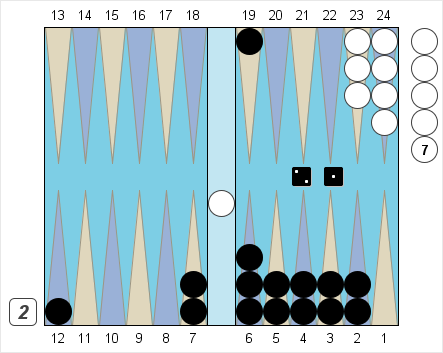
Black – Pips 91 (+56)
Black to Play 2-1
In 501 Essential Backgammon Problems, I divided the game after hitting a shot into two big categories: the Containment Game and the Post-Ace-point Game. The goals of the containment game phase are these:
1) Arrange your men to best contain the opposing checker.
2) Build a full 6-prime.
3) Roll the prime all the way home until your board is filled in.
4) Bring your remaining spares to good points.
After you fill in your board and bring in your spares, you graduate to the final phase, the post-ace-point game, where you actually bear off your checkers. Most recube decisions will come in this phase, although you might have recube decisions in containment games, depending on exactly how many men your opponent managed to bear off.
In this position, we’re in Part 3 of the containment game. Black built his 6-prime and has rolled it almost all the way home. Now he has a 2-1 to play, which gives him lots of choices. What’s he trying to do in this position? Let’s look at a few guidelines for Black.
Rule #1: Don’t break the 6-prime! This rule is crucial. The 6-prime has eliminated any danger of losing a gammon, and once you break it you’ve turned the gammon danger back on. You want to avoid plays like 7/5 12/11 or the super-fancy 2/1 19/17. To see why these plays are bad, look at Rules 2 and 3.
Rule #2: Slot and cover. This is the basic game plan once you have six points in a row. Slot the front of the prime with a spare, then bring up more spares and cover, while keeping the full prime intact. Repeat the process until you’ve moved the whole prime home. In this position, for instance, you would have slotted the ace-point if you had rolled a five. If White rolls an ace and hits, you just bring more checkers around until you can hit again.
This process is so likely to succeed that there’s no need for a play like 7/5 12/11, which creates a third builder for the 1-point while giving White a possibility of escaping with 1-6; you have plenty of time and your plan is easy to implement, so why take any unnecessary risk?
Rule #3: Don’t be overly concerned about hitting the second checker. There is a possibility of Black’s hitting a second checker in this position. White could enter with an ace, and then roll another ace, and then another ace, and Black could hit on the ace-point, and White could immediately hit back, and Black could then roll a deuce — you get the idea. Fuggedaboutit! There’s a much better chance that as you tiptoe around, neglecting to close your board while waiting for White’s aces, you roll some horror shot that messes up your plan entirely. If you can close your board, you’ll be about 60% to win. That’s good enough. Keep the main chance in mind and pursue it.
Rule #4: Watch how 4-4 and 5-5 play. When you can’t slot your 1-point yet, you’ll need to bring your remaining spares closer. As you do, keep track of how 4-4 and 5-5 play. You don’t need to worry about 6-6 and 3-3, because those numbers will close the 1-point. But 4-4 and 5-5 could prove awkward. Try to arrange your spares so that ideally either number will get a checker to the ace-point.
In this position Black is fortunate that two different plays will work: either 19/17 12/11 or 12/9 will slot the one-point after 4-4 or 5-5. I prefer 19/17 12/11 for two reasons: after 5-5 the play will actually make the ace-point, and the play leaves the two spares farther back, which results in a little more flexibility on subsequent rolls.





